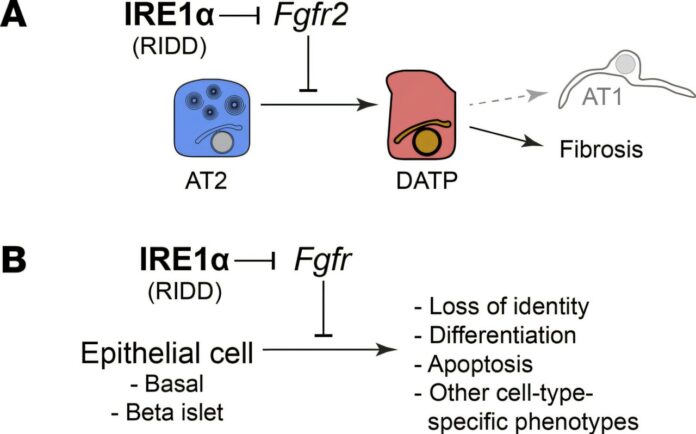Salt, or more precisely the sodium it contains, is very much a “Goldilocks” nutrient. Low sodium levels cause a drop in blood volume, which can have serious, sometimes deadly, health consequences. Conversely, too much salt can lead to high blood pressure and cardiovascular disease.
In modern America, where most people consume a high-salt diet, almost no one is in danger of having too little salt. However, given the critical importance of sodium for body and brain functions, evolution has developed a powerful drive to consume salt in situations where there is a deficiency.
Understanding the brain circuitry that controls salt appetite has proved elusive, but now a new study by University of Iowa researchers has identified the first and, thus far, only neurons necessary for salt appetite.
“Knowing the genetic identity and location of neurons that control this specific behavior is the first, necessary step toward enabling future therapies that specifically increase or decrease salt appetite without affecting other vital functions,” says Joel Geerling, MD, Ph.D., UI associate professor of neurology, senior author of the study in JCI Insight.
Aldosterone triggers salt-appetite neurons
The UI team led by Geerling and first author Silvia Gasparini, Ph.D., made their discovery by teasing out the actions of aldosterone, a key hormone for controlling sodium levels.
Normally, aldosterone is produced when body fluid volume (including blood volume) is low, for example, after sweating without drinking enough fluid, or blood loss, or during an illness with vomiting or diarrhea. Aldosterone tells the kidney and other organs to retain sodium, which helps maintain the existing fluid in the body.
However, when aldosterone is inappropriately high, a condition called primary aldosteronism, blood pressure can rise to dangerous levels. Aldosteronism is the cause of hypertension in as many as 10-30% of all patients with high blood pressure, and the risk of stroke, heart failure, and abnormal heart rhythms is three times higher in these patients than in other patients with hypertension, although it is not clear why.
The UI team focused on an unappreciated aspect of aldosteronism—a tendency to eat more salt. Almost a century ago, studies showed that aldosterone and related hormones cause salt appetite to go up in rats. More recent human studies have also found that patients with aldosteronism consume more salt than other patients with hypertension.
The team first confirmed that lack of sodium in the diet of mice increases aldosterone production and salt intake. It also increases the activity of a tiny group of neurons in the brainstem known as HSD2 neurons. Geerling had previously discovered these HSD2 neurons and had circumstantial evidence suggesting they were responsible for salt appetite.
Next, Geerling and his team used genetically targeted cell deletion to show that the HSD2 neurons were required for aldosterone-driven salt consumption. Moreover, they showed that humans also have a small population of HSD2 neurons in the same part of the brainstem, indicating that the same neural circuit may be relevant to people with elevated aldosterone.
“The most compelling aspect of our findings is the cross-species expression of HSD2 neurons in humans, rats, and pigs,” says Gasparini, a postdoctoral fellow in Geerling’s lab. “This remarkable conservation suggests a fundamental physiological pathway that could have significant implications for understanding and potentially treating sodium-related health conditions.”
Tiny population of cells crucial for salt intake
Overall, the findings suggest that aldosterone acts on the tiny population of HSD2 neurons (there are roughly 200 HSD2 neurons in mice and 1,000 in humans) to induce the highly specific behavior of seeking and consuming sodium. The team’s findings suggest that boosting sodium appetite may be the only central function of HSD2 neurons.
“We are not aware of any other example of a mammalian behavior depending so completely on the integrity of so few neurons,” says Geerling, who is a member of the Iowa Neuroscience Institute. “The total dependency of aldosterone-induced salt intake on the integrity of HSD2 neurons may represent the most delicately cell-type-specific behavioral dependency in the brain.
“Identifying the neurons necessary for aldosterone-induced salt intake improves our understanding of the neural circuitry controlling sodium appetite and provides a promising target for therapeutic strategies to boost sodium appetite in patients with low blood volume and to mitigate excessive salt intake in patients with aldosteronism,” he adds.
With a clearer picture of the neurons necessary for triggering aldosterone-induced salt appetite, the researcher will begin to explore the larger neural circuitry that controls this behavior, and ask more fundamental questions about the deeper, mechanistic basis of appetite control in the brain.
In addition to Geerling and Gasparini, the research team included Jon Resch, Ph.D., Miriam McDonough, Lila Peltekian, Chidera Mitchell, and Marco Hefti, MD.
More information:
Silvia Gasparini et al, Aldosterone-induced salt appetite requires HSD2 neurons, JCI Insight (2024). DOI: 10.1172/jci.insight.175087
University of Iowa
Citation:
Salt-seeking behavior traced to specific brain neurons (2024, December 21)
retrieved 21 December 2024
from https://medicalxpress.com/news/2024-12-salt-behavior-specific-brain-neurons.html
This document is subject to copyright. Apart from any fair dealing for the purpose of private study or research, no
part may be reproduced without the written permission. The content is provided for information purposes only.


